
[ad_1]
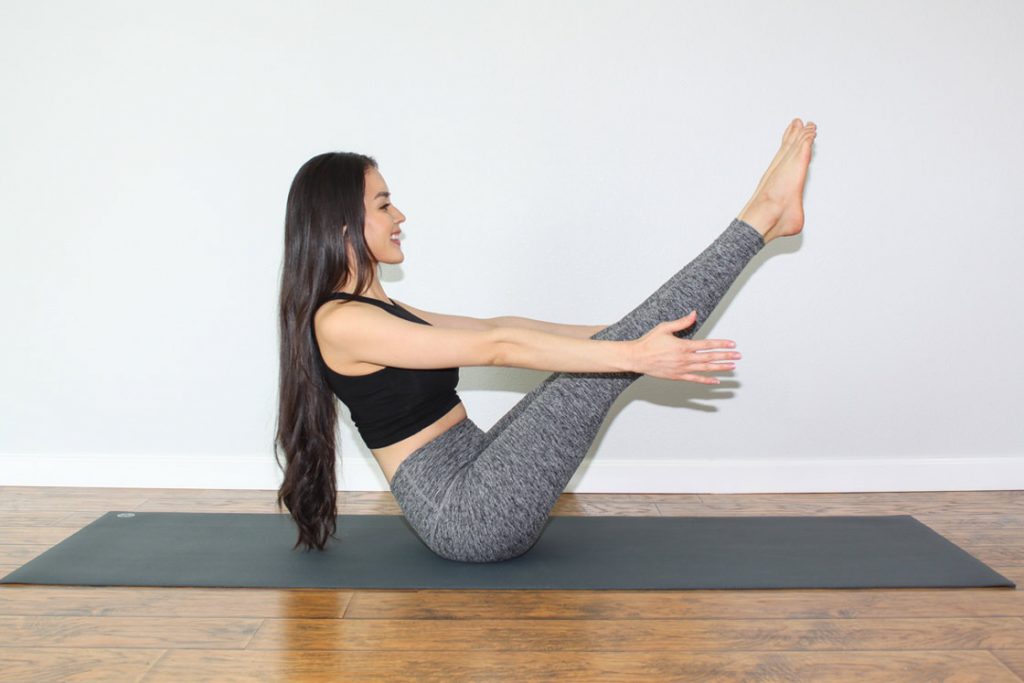
Boat Pose, or Navasana, serves as a superb core-strengthening pose that targets the muscular tissues of the stomach and again. This forward-bending posture requires you to stability your complete physique weight in your tailbone and sitting bones, making it a difficult however rewarding train.
By partaking the core, hips, thighs, and again muscular tissues, Navasana enhances their flexibility and robustness. The physique’s posture in Navasana mimics that of a ship (Nava), which is why it’s aptly named Boat Pose. In the course of the apply of this pose, the physique varieties a distinct ‘V’ form, additional emphasizing its resemblance to a boat.
The best way to Do Boat Pose(Navasana)
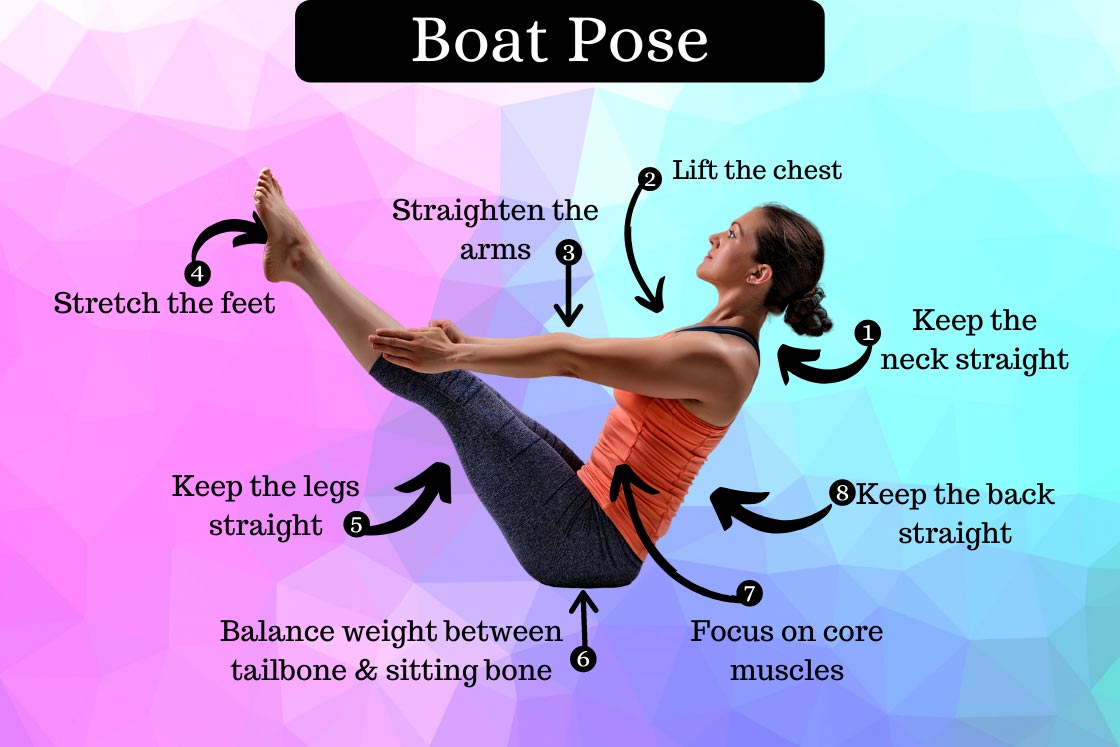
Navasana may look easy in visuals, however is it not so simple as it appears. It requires excessive core energy and an amazing focus to stability the physique. Listed here are the steps to carry out this pose.
Steps to Carry out Boat Pose(Navasana)
- Start by sitting on the ground together with your legs straight and ft flat on the bottom, conserving your backbone straight.
- Bend your knees and place your ft flat on the ground together with your knees pointing upwards. Carry your legs collectively, with the ft and knees of each legs touching.
- Lean again barely, draw your shoulders again, and tilt your torso backward. With an exhalation, raise your ft off the ground, balancing your physique weight between your tailbone and sitting bones. Hold your shins parallel to the ground, and raise your chest.
- Slowly straighten your legs, creating an angle between 20 to 45 levels with the ground. Lengthen your ft, and be certain that your backbone stays straight, and your legs don’t unfold aside.
- Concurrently, increase your arms straight at shoulder degree, parallel to the ground. Your palms ought to face in the direction of your thighs, and your fingers ought to level forwards, making a “V” form together with your physique.
- Take regular breaths and maintain this place for about 5 to eight breaths, which is roughly 10 to twenty seconds.
- To launch the pose, gently carry your legs down, and you need to use your arms for assist if wanted.
- Come again to a seated place and calm down.
Newbie’s Ideas
For rookies, performing Boat Pose (Navasana) will be difficult, however there are a number of modifications and tricks to make it extra accessible.
- Take the Assist of Your Palms: Use your palms for assist. Frivolously seize your decrease thighs together with your palms whereas performing the pose. This can enable you preserve stability and correct physique posture. As you turn out to be extra comfy, attempt doing the pose with out holding your thighs.
- Use Props: Think about using yoga props, equivalent to a yoga strap, to help you at first. Loop the strap across the soles of your ft and maintain it together with your palms. This may help you retain your backbone, arms, and legs straight, making it simpler to take care of the pose.
- Maintain for Brief Intervals: It’s okay in case you can’t maintain the pose for an prolonged interval at first. Begin by holding the pose for 1-3 breaths, which is roughly 5-15 seconds. As you apply repeatedly, progressively improve the length of your maintain.
- Associate Help: When you’re discovering it significantly difficult, contemplate partnering with somebody or in search of assist from a yoga instructor. Having a buddy or teacher help you with the pose can offer you the mandatory assist and steering as you’re employed in your Boat Pose.
Precautions and Contraindications
Whereas practising Navasana, you must preserve the next issues in thoughts.
- Keep away from rounding your again; preserve a straight again all through the pose to maintain the main focus in your core muscular tissues.
- Carry out Navasana slowly and gently; keep away from speeding by means of it. Incorrect execution might result in discomfort or ache within the core muscular tissues.
- In case you have a latest or extreme damage in your decrease again, hips, thighs, or stomach, chorus from practising this asana, because it closely targets these areas and may have antagonistic results on accidents.
- People with low or hypertension, in addition to these vulnerable to complications or migraines, shouldn’t try Boat Pose resulting from its potential impression on blood strain and potential discomfort.
- Keep away from practising Boat Pose in the course of the menstrual cycle, because it locations strain on the decrease stomach and decrease again, which will be dangerous throughout this time.
Boat Pose (Navasana)Variation
Boat Pose has a number of variations that add complexity and goal completely different muscle teams. Listed here are a number of Boat Pose variations:
- Half Boat Pose (Ardha Navasana): On this variation, the physique creates a partial “V” form with the underside on the ground and the knees bent.
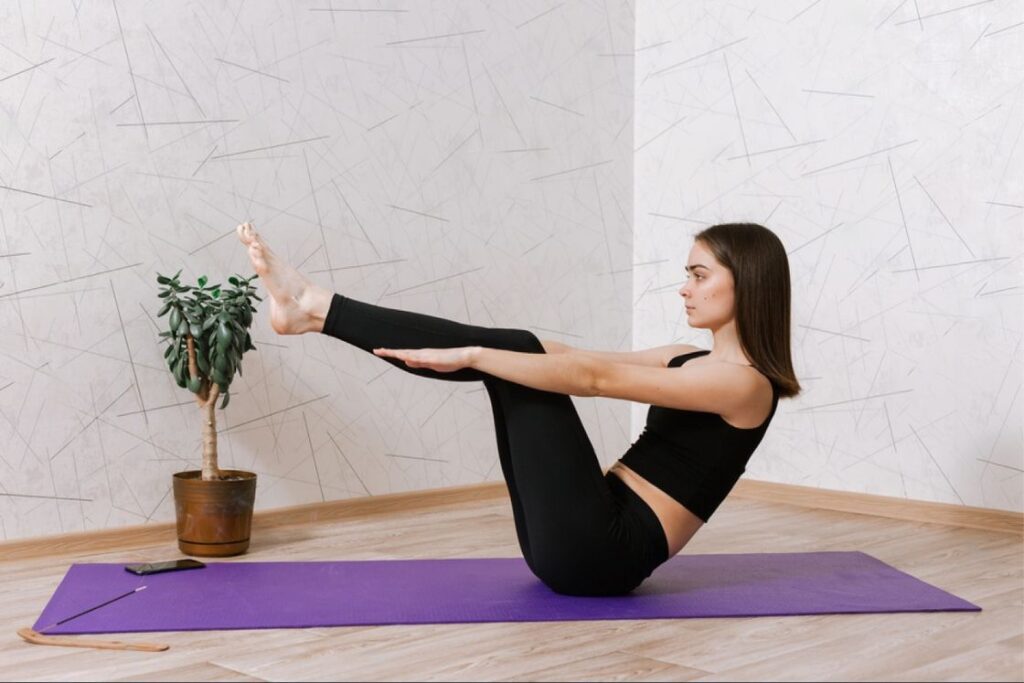
2. Low Boat Pose: On this variation, your legs and higher physique are nearer to the bottom, making a extra intense problem for the core muscular tissues.
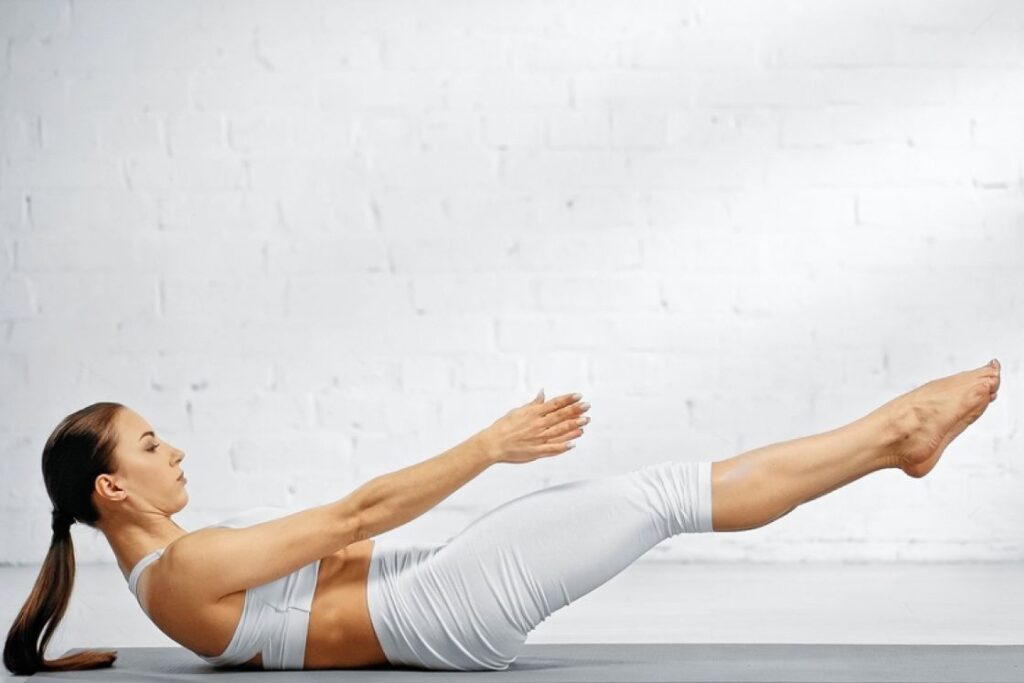
3. Revolved Boat Pose: Revolved Boat Pose, often known as Parivrtta Navasana, is a difficult yoga variation that mixes the core-strengthening advantages of Boat Pose with a twist to reinforce spinal flexibility and stability. It includes sitting together with your legs lifted and twisted to 1 facet, offering a complete exercise for the core and indirect muscular tissues whereas enhancing your total physique coordination.
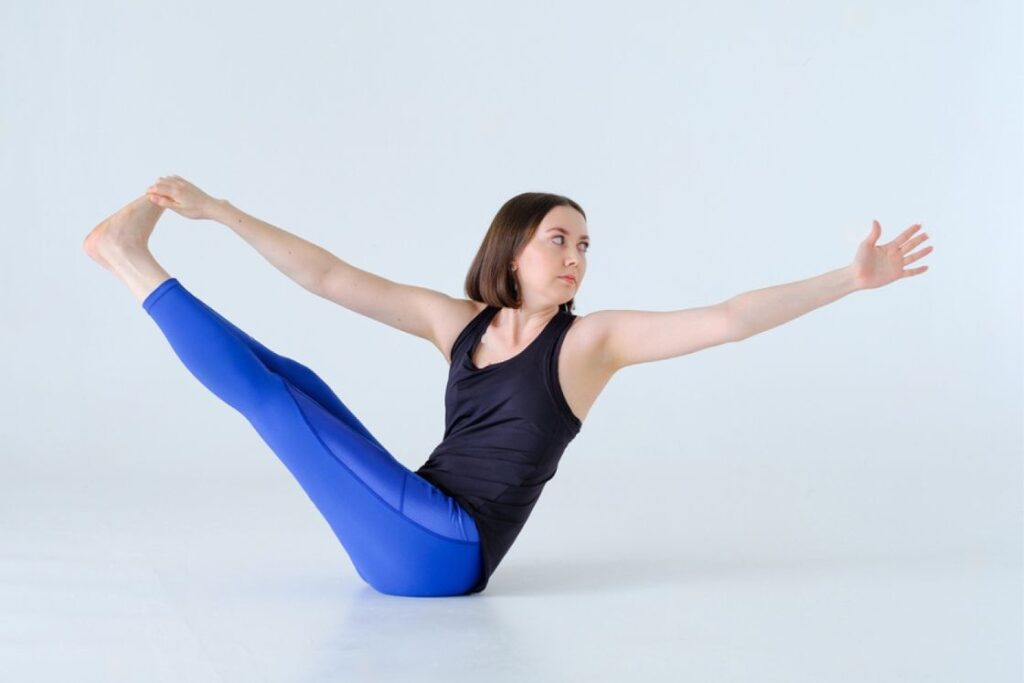
4. Each Huge Toe Pose: Each Huge Toe Pose, often known as Ubhaya Padangusthasana, is a sophisticated yoga pose that challenges stability and suppleness. On this pose, you sit together with your legs prolonged, raise each huge toes, and maintain them, offering a novel stretch and strengthening for the legs and core muscular tissues.
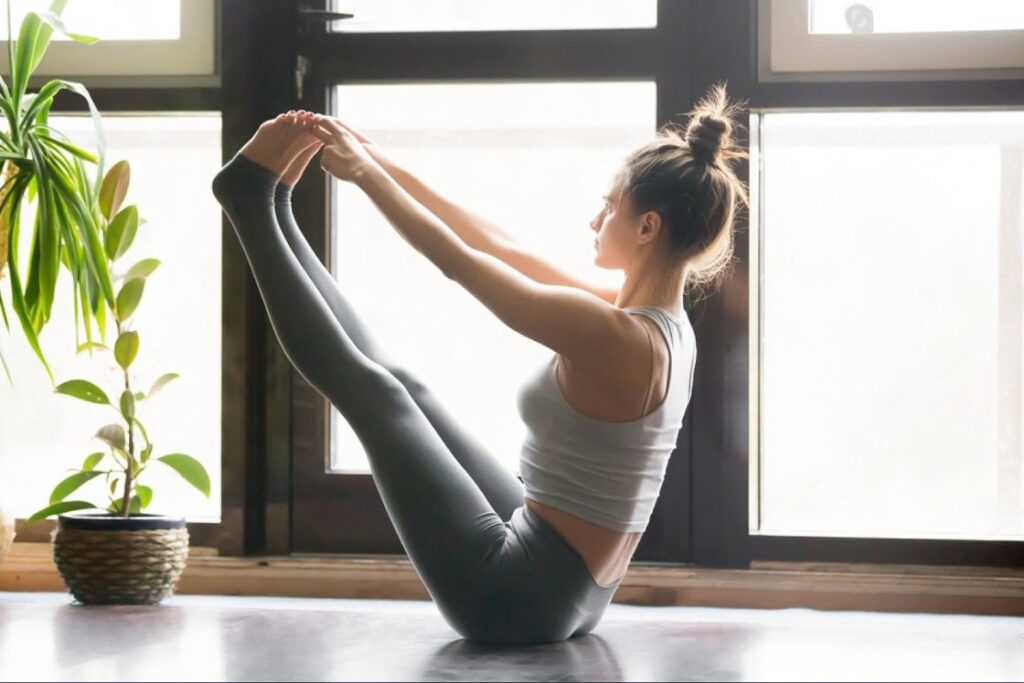
Advantages of Boat Pose
- Enhanced Core Power
Boat Pose engages the muscular tissues of the core, which incorporates the abdominals and decrease again. Common apply can considerably improve core energy, serving to you obtain a extra toned and secure midsection.
2. Stomach Firming
This pose particularly targets the belly muscular tissues, serving to to tone and sculpt the muscular tissues of the stomach. It contributes to a flatter and extra outlined abdomen.
3.Improved Digestive Well being
Boat Pose massages the belly organs, together with the liver, kidneys, and digestive system. This could improve digestion, improve metabolism, and assist total digestive well being.
4. Assist for Weight Administration
The train of the core and again muscular tissues in Navasana can assist in burning extra fats saved in these areas. In consequence, it might assist weight administration and fats loss.
5. Again Well being and Flexibility
By inserting strain on the decrease again muscular tissues, Boat Pose acts as an train for this space. It helps strengthen the decrease again, promotes flexibility, and may scale back the chance of again issues.
6. Firming of Hips and Thighs
Navasana additionally works on the muscular tissues of the hips and thighs, firming and strengthening them. This could improve the general form and energy of the decrease physique.
7.Stress Discount and Rest
Practising Boat Pose, like many yoga poses, may help scale back stress and stress. It promotes rest, reduces stress within the hip and thigh muscular tissues, and has a chilled impact on the thoughts.
8. Improved Blood Circulation
The bodily exercise concerned on this pose enhances blood circulation all through the physique. Improved circulation can have varied well being advantages, together with psychological readability and elevated power.
FAQs Boat Pose
Boat Pose will be difficult for rookies as a result of energy and stability required. It’s endorsed to start out with modifications or variations of the pose and progressively work in the direction of the total expression of Boat Pose as your energy and suppleness enhance.
As a newbie, you can begin by holding Boat Pose for 10-20 seconds and progressively improve the length as you turn out to be extra comfy with the pose. Superior practitioners can maintain the pose for as much as a minute or longer.
It’s advisable for pregnant girls to seek the advice of with their healthcare supplier and a licensed prenatal yoga teacher earlier than practising Boat Pose throughout being pregnant. Modifications could also be vital to make sure security.
The frequency of practising Boat Pose is dependent upon your health degree and targets. You possibly can incorporate it into your yoga routine a number of occasions every week for the very best outcomes.
Variations of Boat Pose embrace Half Boat Pose, Revolved Boat Pose, Low Boat Pose and completely different arm and leg positioning variations. These present choices to adapt the pose to your health degree.
Widespread errors embrace rounding the again, letting the shoulders collapse, and never partaking the core muscular tissues. It’s necessary to take care of correct type and alignment.
In Boat Pose, give attention to deep and managed respiration. Inhale as you raise your legs and torso, and exhale as you maintain the pose. Sustaining a gradual breath is crucial for stability and stability.
[ad_2]